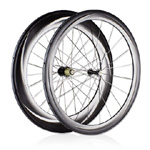How to disassemble, re-grease, reassemble and adjust a cup and cone bottom bracket.
Today we’ll learn how to overhaul and re-grease an adjustable bike bracket. There is something you need to prepare.
- To remove the cranks you’ll need a crank puller, a 17mm open end wrench and a large adjustable wrench.
- To overhaul the bottom bracket you’ll need a bottom bracket wrench or a pin spanner, a hooked lock ring wrench, and a 36mm wrench.
- For re-greasing the bearings you’ll need some cleaning solvent and waterproof grease, a rag, a toothbrush and a small container to clean the bearing cages.
Disassemble
Begin by removing the cranks. Once the cranks are removed, loosen and remove the lock ring on the non-drive or left side of the bike by turning counter-clockwise. Once the locking is removed you should be able to easily loosen and un-thread the bearing race using either a pin spanner or a bicycle bracket wrench.
Now pull the spindle and both bearing cages out of the frame. It’s important to remember which way the spindle came out, as they are directional. The drive side usually has a longer distance from the bearing race to the end of the threads. Wipe off the bearing cages, drop them into the solvent, and let them soak while you use your rag to clean the spindle and both outer bearing races.
Tighten the drive-side bearing race by turning it counter-clockwise with your 36mm wrench. Unless you are replacing the bottom bracket, there is no need to remove it.
Inspect
Shine a flashlight into your bike bracket shell to inspect the bearing race for pitting and wear. Inspect your other bearing race and then carefully inspect the spindle. Most wear occurs on the spindle’s bearing races. If you see pitting here you should take it to your local bike shop for a replacement.
Clean
Now clean both bearing cages with a toothbrush and solvent, and then set them aside to air-dry. These should also be replaced if they are worn or have bent cages.
Grease
Apply a layer of grease on both bearing races and cages. A grease gun makes it easy to squirt grease inside the gaps between the bearings. Then place the bearing cages into both races. The rounded side of the cage should be facing down into the bearing race. Seal them in with another layer of grease.
Reassemble
Now insert the spindle the same way you removed it. Wipe off any excess grease that comes out on the spindle. Grease the threads inside the bottom bracket shell, and then slide the outer race and bearing cage onto the spindle. Thread it on all the way clockwise but don’t tighten it. Again you’ll need to wipe off excess grease.
Adjust
Thread on the lock ring finger-tight. Before adjusting the bottom bracket, first install the drive-side crank arm and tighten it as shown in the crank installation tutorial. This will help us make a proper adjustment. Now hold the inner race firmly with your wrench or spanner and tighten the lock ring. When properly adjusted the spindle should spin smoothly. If it doesn’t, you’ll have to loosen the lock ring, back off the inner race a little bit, and then tighten it again.
Check for play by placing the crank arm close the frame and pushing and pulling it against the frame. There should be no movement. If it feels loose, you’ll have to loosen the lock ring, tighten the inner race a little bit, and then tighten the lock ring again. When the adjustment is correct, install and tightens the left crank arm and you’re done!
Now, have you known how to overhaul a bike bracket? If you are interested in learning more information about bottom bracket and other bicycle parts, try to check out the website of G-MA Engineering Co., Ltd.: www.aerozinebike.com. There are kinds of high quality bike components at G-MA. Visit its product pages to find you need.
Article Source: http://bicycletutor.com/bottom-bracket/

